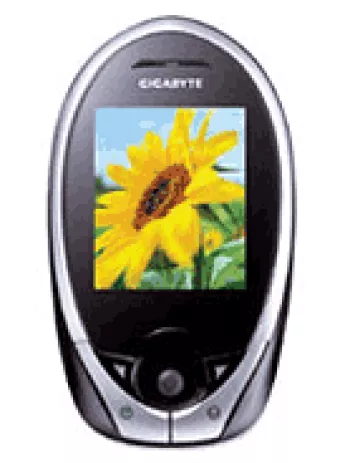
Overview of the Device
The Gigabyte GSmart i120 is a smartphone introduced to the market in December 2006. Aimed at users of the early smartphone era, it combines the utility of a PDA with phone functionalities. Known for its distinctive silver-black design and functionalities powered by Microsoft Windows Mobile 5.0, the device is a representative of the transitional phase from basic mobile phones to more sophisticated smartphones.
Design and Build
At a compact size of 106.6 x 53.2 x 19.8 mm and a weight of 130 grams, the GSmart i120 is convenient to carry and handle. The metallic and plastic silver-black exterior provides a sleek and professional look, appealing to business professionals and tech enthusiasts of its time. The device feels sturdy, and the tactile buttons add to its usability, despite the era's limited touchscreen technology.
Display Features
The GSmart i120 is equipped with a 2.4-inch TFT resistive touchscreen boasting 256K colors, although only 65K effectively. With a resolution of 240 x 320 pixels, it ensures clarity for basic functions and user interface operations. The screen-to-body ratio is about 31.5%, which was typical for devices of that period.
Camera Capabilities
Offering a 2MP rear camera with LED flash, this smartphone captures images at a quality sufficient for standard usage like casual photography and video recording. However, it lacks a front-facing camera, a feature that became standard in later smartphone models.
Performance and Platform
Under the hood, the device runs on an Intel PXA272 416 MHz processor, which was considered competent for handling tasks such as managing contacts, corporate email, and browsing in 2006. Operating on Microsoft Windows Mobile 5.0, it aligns with PocketPC functionality, allowing for a variety of applications directed at productivity and entertainment.
Memory and Storage
Internally, the GSmart i120 provides 64MB of RAM coupled with 256MB of ROM. While this may seem minimal by today’s standards, it accommodated the operating needs of applications available at the time. Additionally, storage can be expanded via miniSD cards, allowing users to store more multimedia files and applications.
Networking and Connectivity
The device is equipped with GSM technology supporting 900, 1800, and 1900 frequency bands, making it compatible with a range of network providers globally. It supports GPRS Class 10 for data but does not support EDGE. Bluetooth 1.2 and Wi-Fi 802.11 b/g enable wireless connectivity, while the miniUSB 1.1 port allows physical connections for data transfer and charging.
Sound and Multimedia
The device lacks a loudspeaker, which could be seen as a limitation for media consumption and hands-free calling. Instead, it supports vibration and downloadable polyphonic as well as MP3, WMA, AMR, MID ringtones, providing users with customization options for alerts and notifications. There's no 3.5mm headphone jack, necessitating the use of compatible accessories for audio playback.
Battery Life
Powered by a removable Li-Ion battery, it offers an option between a capacity of 920 mAh and 1300 mAh. In practical use, standby time reaches up to 125 hours, and talk time extends up to 3.5 hours, which was relatively acceptable for early smartphones. Users, however, needed to manage their device use to ensure daily operation without needing frequent charges.
Additional Features
The browser supports WAP 2.0/xHTML and HTML through PocketIE, although the connection speed and rendering capacity match the technological limits of its time. The device also includes an FM Radio, somewhat mitigating the multimedia deficiencies by providing auditory entertainment.
Market Release and Status
Announced in December 2006, the GSmart i120 was eventually discontinued as technology advanced. Priced initially around 320 EUR, it was positioned for both professional use and tech enthusiasts interested in smart technology during its time.
Conclusion
The Gigabyte GSmart i120 stands as a testament to the burgeoning smartphone market during its period, bridging the gap between feature phones and more advanced mobile devices. Although outdated by today's standards, it offered crucial insights and functionalities that helped lay the groundwork for future technological advancements.
Key Features of Gigabyte GSmart i120
- GSM Technology: Supports 2G bands GSM 900 / 1800 / 1900
- Compact Design: Dimensions of 106.6 x 53.2 x 19.8 mm and weight of 130 g
- TFT Resistive Touchscreen: 256K colors with a 2.4-inch display
- Microsoft Windows Mobile 5.0: Powered by an Intel PXA272 416 MHz processor
- Ample Storage: 64MB RAM and 256MB ROM with miniSD card slot
- 2 MP Main Camera: Equipped with an LED flash and video recording capabilities
- Wi-Fi Connectivity: WLAN with 802.11 b/g support
- FM Radio and Bluetooth: Bluetooth 1.2 and FM radio functionality
- Removable Battery: Offers a choice between 920 mAh and 1300 mAh capacities
Drawbacks of Gigabyte GSmart i120
- Limited network technology: Only supports GSM, no 3G/4G support.
- No EDGE support limits web browsing speed.
- The device is discontinued, making it difficult to find support or parts.
- Small screen size with low screen-to-body ratio (~31.5%).
- Low-resolution display (~167 ppi density).
- Outdated operating system: Microsoft Windows Mobile 5.0.
- Limited internal memory: only 64MB RAM and 256MB ROM.
- No front-facing (selfie) camera.
- No loudspeaker and lacks a 3.5mm audio jack.
- Older Bluetooth version (1.2) limits connectivity options.
- No positioning or GPS feature.
- Poor battery life with up to 3.5 hours talk time only.

View Also
More Phones
All Rights Reserved +13665 Phones © Mobilawy 2025

























